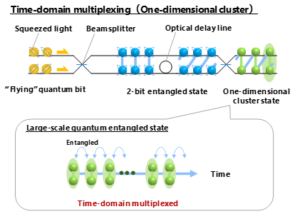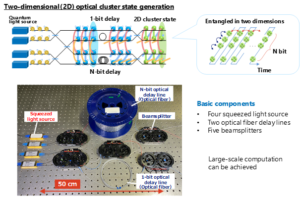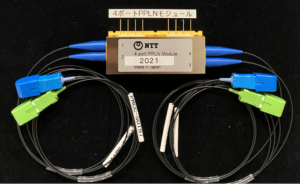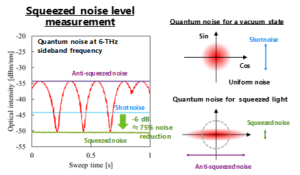TOKYO, Dec. 23, 2021 — NTT Corporation (NTT, President & CEO: Jun Sawada, Chiyoda-ku, Tokyo) in cooperation with the University of Tokyo (President: Teruo Fujii, Bunkyo-ku, Tokyo) and RIKEN (President: Hiroshi Matsumoto, Wako-shi, Saitama) has developed an optical fiber-coupled quantum light source (squeezed light source) (*1), which is a key technology for realizing a fault-tolerant large-scale universal optical quantum computer.
Quantum computers are being researched and developed worldwide because they are capable of parallel computational processing using unique phenomena to quantum mechanics such as quantum superposition states and quantum entanglement states. While various methods are being considered, the optical quantum computer using photons has many advantages. For example, it does not require the low temperature and vacuum equipment required by other methods, which makes it compact. Also, by creating a time-domain-multiplexed quantum entangled state, the number of qubits can be easily increased without micro integration of circuits or parallelization of equipment. In addition, high-speed computational processing is possible thanks to the broadband nature of light. Furthermore, quantum error correction has been theoretically shown to be possible by using continuous variables of light that take advantage of the parity of photons, rather than by using discrete variables that use the presence or absence of photons. This method has a high compatibility with optical communication technologies such as low-loss optical fibers and highly functional optical devices, which makes dramatic progress toward the construction of universal large-scale fault-tolerant optical quantum computers.
To realize optical quantum computers, one of the most important components is a quantum light source generating squeezed light, which is the origin of quantum nature in optical quantum computers. Especially, an optical fiber-coupled quantum light source is highly desired. Squeezed light is a non-classical light that has an even number of photons and squeezed quantum noise and is used to generate quantum entanglement. In addition, squeezed light plays an extremely important role in quantum error correction, since quantum error correction is made possible by utilizing the parity of the number of photons. To achieve a large-scale universal fault-tolerant optical quantum computer, we need a fiber-coupled squeezed light source with highly squeezed quantum noise and photon number parity that is maintained even in high-photon-number components. For example, a squeezing level of over 65% is required to generate time-domain multiple quantum entanglement (two-dimensional clustered states) (*2) that can be used for large-scale quantum computation. However, such devices have never been developed because of the difficulty of generating the squeezed light with high quality.
In this study, we have developed a new optical fiber-coupled quantum light source that operates at optical communication wavelengths. By combining it with optical fiber components, we successfully generate continuous-wave squeezed light with more than 75% squeezed quantum noise with more than 6 THz sideband frequency even in an optical fiber closed system for the first time. This means that the key device in optical quantum computers has been realized in a form that is compatible with optical fibers while maintaining the broadband nature of light. This will enable the development of an optical quantum computer in a stable and maintenance-free system using optical fibers and optical communication devices. This will greatly advance the development of rack-sized large-scale optical quantum computers.
The results of this research are to be published in the American scientific journal Applied Physics Letters on December 22, 2021 (US time). This paper has also been selected as an “Editor’s Pick” paper. A part of this research was supported by the Japan Science and Technology Agency (JST) Moonshot Research and Development Program.
Highlights
- We have developed an optical fiber-coupled high-performance squeezed light source module, which will be a key device to realize a rack-sized optical quantum computer.
- By using the developed fiber-coupled quantum light source module and optical communication devices, continuous-wave squeezed light with quantum noise suppressed by more than 75% over a wide bandwidth of more than 6 THz has been successfully generated in an optical fiber closed system for the first time.
- This achievement makes it possible to develop an optical quantum computer on a realistic scale in a stable and maintenance-free optical system using optical communication devices and will greatly advance the development for a fault-tolerant large-scale universal optical quantum computer.

Background
Research and development to realize a universal quantum computer is being actively conducted worldwide. Recently, quantum computation with about 100 physical qubits has been reported using superconducting circuits. However, to realize a fault-tolerant universal quantum computer, about one million physical qubits are required. Therefore, increasing the number of qubits has become a major challenge in quantum computation. To realize a million qubits by superconducting circuits or trapped ions, approaches to increase the number of qubits have been taken by integrating its elements and parallelizing equipment. On the other hand, an optical quantum computer is expected to be capable of overwhelmingly large-scale universal quantum computation that uses a time-domain multiplexing technique (*3) and measurement-induced quantum manipulation (*4), which is a completely different approach from conventional methods. In the time-domain multiplexing technique, we divide continuously flying light into time segments and place information on the separated light pulses. By this method, we can easily increase the number of qubits on the time axis without increasing the size of the equipment (Fig. 1).

Furthermore, quantum error correction has been theoretically shown to be possible by using the parity of the number of photons and the continuous variables of light. By using a low-loss optical fiber as a propagation medium for flying optical qubits, large-scale quantum entangled states will be able to be generated freely and stably in combination with optical communication devices. Specifically, with only four squeezed light sources, two optical fibers of different lengths (optical delay lines), and five beam splitters (Fig. 2), large-scale two-dimensional clustered states can be generated that are necessary for universal quantum computations. This is an approach that does not necessarily require integration or large-scale equipment and makes it possible to realize universal quantum computation on the realistic equipment scale of a rack, whereas methods using superconducting circuits or trapped ions require integration of elements or parallelization of equipment. In addition, this method can conduct high-speed calculations by taking advantage of the high frequency of light. This means that not only can high-speed quantum algorithms be implemented but also their clock frequencies can be high, making optical quantum computers the ultimate high-speed information processing technology.
So far, we have demonstrated various optical quantum operations for realizing this optical quantum computer by using a spatial optical system consisting of many mirrors aligned with high precision. This is to minimize the optical loss of light and enhance the interference between light as much as possible. However, if the mirrors are misaligned even slightly, the desired characteristics will not be achieved, and the path of the light had to be readjusted for each experiment. For these reasons, to realize a practical use optical quantum computer, an optical system must be used that is closed to the optical waveguide, such as an optical integrated circuit or optical fiber, which has excellent operational stability and is maintenance-free. In particular, the most fundamental element in optical quantum computers is squeezed light. This non-classical light has the squeezed quantum noise of the amplitude or phase of a wave, which is a non-commutative pair of physical quantities. Since this light is difficult to generate and is easily degraded by optical loss, the light from an optical fiber-coupled squeezed light source tends to be poor. Especially, more than 65% squeezed light, which is necessary for generating time-domain-multiplexed large-scale quantum entangled state (two-dimensional cluster states) has not been realized with an optical fiber closed configuration.

Technical progress
We have developed a low-loss fiber-coupled quantum light source module (optical parametric amplification module) (Fig. 3). We have achieved low loss by renewing the fabrication method of the periodically poled lithium niobate (PPLN) waveguide, which is the main part of the module. The module was assembled as a low-loss optical fiber-coupled module by using the assembling technique of optical communication devices that NTT has cultivated. While connecting optical fiber components, we successfully measured squeezed light in which quantum noise is squeezed to more than 75% with a bandwidth of more than 6 THz (Fig. 4). This means that the quantum states required for optical quantum computing can be generated and measured even in a fully closed system in optical fibers. Therefore, the developed fiber-coupled quantum light source will make it possible to realize a stable and maintenance-free optical quantum computer on a realistic scale, which will greatly advance future development.

In this experiment, we used a new method in which the first module generates squeezed light and the second module converts the optical quantum information into classical light information. The optical parametric amplifier developed as the light source is used in the opposite direction to achieve optical amplification that maintains photon number parity. Unlike the conventional balanced homodyne detection technique, this measurement method can amplify and convert the quantum signal into a classical optical signal without changing it into electrons. Thanks to this, it enables overwhelmingly fast measurements. This technology can be used to realize all-optical quantum computers in the future and will greatly contribute to realizing all-optical quantum computers that operate at terahertz clock frequencies and are overwhelmingly fast.
Future works
As a first step, we will develop an optical quantum computer composed of optical fiber components in combination with various optical quantum operations that we have developed so far. In addition, we will improve the quantum noise squeezing ability of the quantum light source to realize a fault-tolerant large-scale universal optical quantum computer.
Support for this research
This research was supported by the Japan Science and Technology Agency (JST) Moonshot R&D Project, Moonshot Goal 6: “Realization of a fault-tolerant universal quantum computer that will revolutionize economy, industry, and security by 2050” (Program Director: Katsuhiro Kitagawa, Professor, Graduate School of Engineering Science, Osaka University). R&D project “Development of Large-scale Fault-Tolerant Universal Optical Quantum Computers” (Project Manager: Akira Furusawa, Professor, Graduate School of Engineering, The University of Tokyo).
Comment of project manager
Until now, it was thought that integrated circuits were essential for the realization of a large-scale quantum computer. However, this success shows that integrated circuits are not necessary and that, by using the developed modules and optical fiber components, we can realize large-scale optical quantum computer. With this achievement, the realization of a large-scale quantum computer has become a reality, and it can be said that a game-changing technology has been born.
Glossary
*1 Squeezed light source
A device that generates light in a state in which one of the quantum fluctuations (quantum noise) of a non-commutative pair of physical quantities is compressed. It is realized by a medium that effectively induces nonlinear optical phenomena.
*2 Two-dimensional (2D) cluster state
A large-scale quantum entangled state that can realize any quantum computation pattern. In 2019, Professor Akira Furusawa and his colleagues at the University of Tokyo realized a two-dimensional optical cluster state with more than 10,000 optical qubits. [Ref. 1]
*3 Time-domain-multiplexing technique for generation of quantum entanglement
A method of generating large-scale entangled states from a limited number of quantum light sources by temporally separating the light emitted from a continuous quantum light source and interfering with the separated quantum wave packets (pulses) with an optical delay interferometer.
*4 Measurement-based quantum computation
A method that can perform universal quantum computation equivalent to the gate-based quantum computer, which has been researched worldwide. Unlike conventional gate-based quantum computing, in which individual qubits are entangled by gate operations, this method involves preparing a large-scale quantum entanglement in advance. By observing some qubits, we can manipulate the remaining qubit.
Reference
W. Asavanant, et al., “Generation of time-domain-multiplexed two-dimensional cluster state,” Science 366, 373 (2019).
Publication Information
Takahiro Kashiwazaki, Taichi Yamashima, Naoto Takanashi, Asuka Inoue, Takeshi Umeki, and Akira Furusawa
“Fabrication of low-loss quasi-single-mode PPLN waveguide and its application to a modularized broadband high-level squeezer,” Applied Physics Letters, DOI: 10.1063/5.0063118.
Source: NTT Corporation


























































